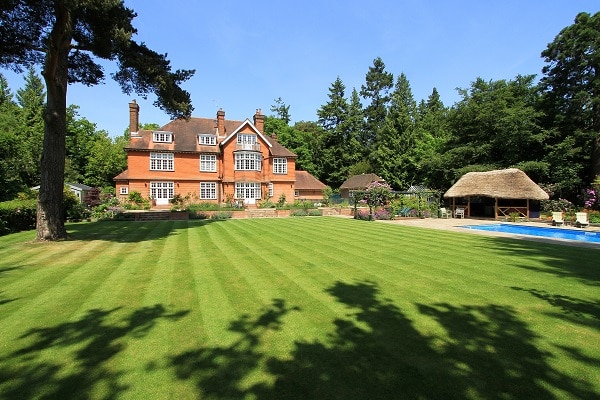Home / Information & advice / Turf & Lawns / Creating a new Lawn - preparation and laying / Shaded lawns – turf choice and maintenance
Maintaining a healthy green lawn requires an understanding of turf and the environment in which it lives. There are few situations where one answer is the definitive answer to a given problem. This is due to the fact that turf is subject to changes in the seasons, variations in weather and the specific conditions found in any one garden.
Being a green plant organism, turf grass plants must have light along with a balance of heat, water, food and air. Living in an outdoor environment a lawn will be subject to change due to the impact of flora and fauna. The quantity and severity of these various elements, along with the degree of traffic endured, will determine the health of a lawn dependent on the maintenance regimes used.
Shade is present in virtually all gardens to some extent, and it is also an issue Rolawn is frequently asked about. Understanding the theory of how shade impacts on turf will help you manage the shade within your garden. Shade is a condition that may require a relatively small adjustment to annual maintenance regimes to create a green healthy lawn, but it can also be something that creates an environment where we have to accept that no turf grass plant is going to thrive.

Photosynthesis is the chemical process by which a plant turns sunlight into food for the plant to consume. This food fuels plant development, growth and reproduction. Consequently, without sunlight a turf grass plant will be weakened, growth will be slow and potentially it will not reproduce. The worst case scenario is insufficient sunlight to sustain plant life.
The turf environment is the ever changing conditions in which the turf grass plant is living and it must be remembered this is always a combination of factors; of which shade is just one. Turf grass plants, as a group, are not well adapted to shade, although some have a greater tolerance than others. In general, all will require some degree of additional help.
The key is to focus on trying to improve the turf environment to encourage the more shade tolerant grass types to be stronger, establish well and dominate. For them to establish correctly and be more efficient under shade and possibly drought conditions strong root growth is essential.
Lawns are often in almost total shade for most of the day, retain excessive moisture, have turf that is thinning out and a high content of moss. The environmental issues are:
Trees and surrounding foliage create different levels of shade, dependent on their branch and leaf structure, but they are usually very efficient at capturing water. Consequently, the problems of shade are often combined with the problems of insufficient water. The environmental issues are:
When assessing the effects of shade it is fair to say that if turf grass plants are surviving, but in relatively poor condition, there should be scope for making improvements. If turf grass plants are not present it may be time to consider an alternative landscaping scheme.
The following is given as a system to aid turf management in shade, however, it is important to understand that a combination of all measures is probably required. The turf environment requires a balanced overall approach.
Dependent on the degree and type of shade, different types of turf and maintenance regimes will be best suited. This will range from a slightly higher sympathy for the turf, through to accepting in some shaded areas grass will simply not grow. Our advice will not cover all circumstances but is given as a guide to the general principles of managing turf subject to shade.
Rolawn turf has been developed over the course of almost 50 years and is sown with seed types (cultivars) that produce some of the most shade tolerant turf grass plants available. Rolawn work very closely with grass seed suppliers and the Sports Turf Research Institute (STRI), the foremost independent turf agronomy research experts in the UK, to select the finest seeds and seed types (cultivars).
The STRI, along with other turf experts, have established that fine fescues are the most shade tolerant turf cultivars. Rolawn sow all their turf with a high percentage content of these cultivars. Fescues have the added benefit of being able to cope well with drought conditions. This is particularly relevant for lawns under trees, as often the shade is combined with drought like conditions. Medallion Turf is an adaptable product that has a dynamic ability to alter over time according to its environment. It has a balanced cultivar mix which is why it is ideal for a wide variety of applications from sports pitches to show gardens at leading flower shows; consequently, it can adapt to gardens that have a mixture of shaded and non shaded areas if maintained correctly.
For overseeding and maintenance regimes Rolawn Lawn Seed is available, along with GroRight® Lawn Establishment Fertiliser.
Rolawn Bark is an excellent ground covering product, ideal for use in areas where an alternative to a lawn is necessary.
You can sign up to our newsletter to receive free seasonal lawn care advice and reminders of essential maintenance, as well as general horticultural advice and special offers from Rolawn.